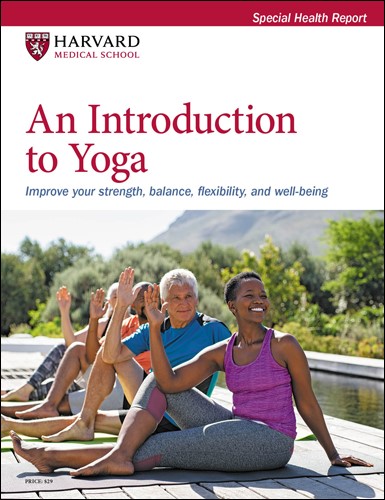Harvard Health Blog
Yoga for people with back pain

Whenever my lower back gets tight (which happens more often than not after being glued to my work chair for hours on end), I sit on the floor and slowly move into my favorite yoga pose: half lord of the fishes, also known as a seated spinal twist. Just a twist to the left and right never fails to restore my sore back.
Yoga is one of the more effective tools for helping soothe low back pain. The practice helps to stretch and strengthen muscles that support the back and spine, such as the paraspinal muscles that help you bend your spine, the multifidus muscles that stabilize your vertebrae, and the transverse abdominis in the abdomen, which also helps stabilize your spine.
But unfortunately, yoga is also the source of many back-related injuries, especially among older adults. A study published in the November 2016 Orthopedic Journal of Sports Medicine found that between 2001 and 2014, injury rates increased eightfold among people ages 65 and older, with the most common injuries affecting the back, such as strains and sprains. So, the question is this: how can you protect an aching back from a therapy that has the power to soothe it?
Proper form is especially important for people with back pain
The main issue with yoga-related back injuries is that people don't follow proper form and speed, says Dr. Lauren Elson, instructor in medicine at Harvard Medical School. "They quickly 'drop' into a yoga pose without gradually 'lengthening' into it."
This is similar to jerking your body while lifting a dumbbell and doing fast reps instead of making a slow, controlled movement, or running on a treadmill at top speed without steadily increasing the tempo. The result is a greater chance of injury.
In yoga, you should use your muscles to first create a solid foundation for movement, and then follow proper form that slowly lengthens and stretches your body. For example, when I perform my seated twist, I have to remember that the point of the pose is not to rotate as fast and far as possible. Instead, I need to activate my core muscles and feel as though my spine is lengthening. Then I can twist slowly until I feel resistance, and hold for as long as it's comfortable and the tension melts away.
Starting yoga if you have back pain
Talk to your doctor first about whether it's okay to begin a yoga program if you suffer from low back pain. Dr. Elson suggests staying away from yoga if you have certain back problems, such as a spinal fracture or a herniated (slipped) disc.
Once you have the green light, you can protect your back by telling your yoga instructor beforehand about specific pain and limitations. He or she can give you protective modifications for certain poses, or help guide you through a pose to ensure you do it correctly without stressing your back. Another option is to look for yoga studios or community centers that offer classes specifically designed for back pain relief.
Remember that the stretching and lengthening yoga movements are often what your low back needs to feel better, so don't be afraid to give it a try. "By mindfully practicing yoga, people can safely improve their mobility and strength while stretching tight and aching back muscles," says Dr. Elson.
About the Author

Matthew Solan, Executive Editor, Harvard Men's Health Watch
Disclaimer:
As a service to our readers, Harvard Health Publishing provides access to our library of archived content. Please note the date of last review or update on all articles.
No content on this site, regardless of date, should ever be used as a substitute for direct medical advice from your doctor or other qualified clinician.
















